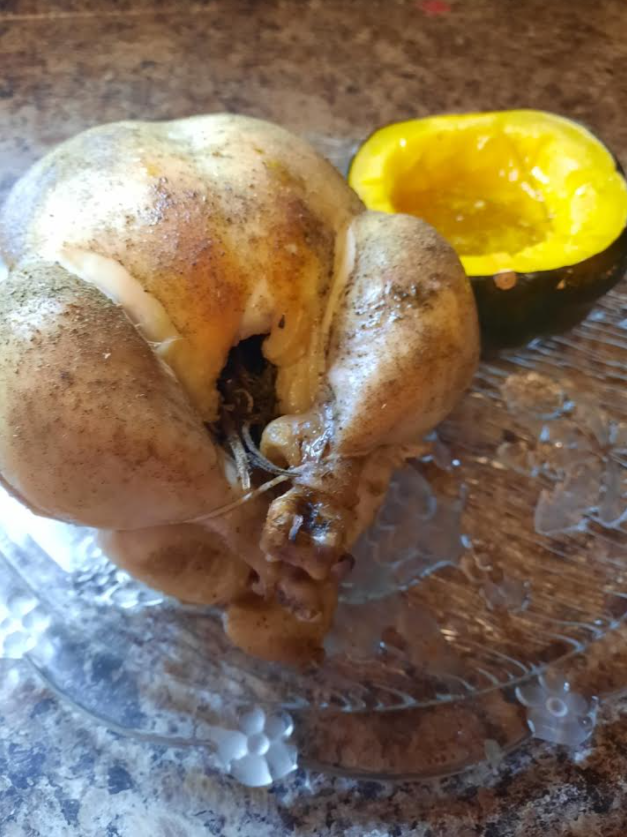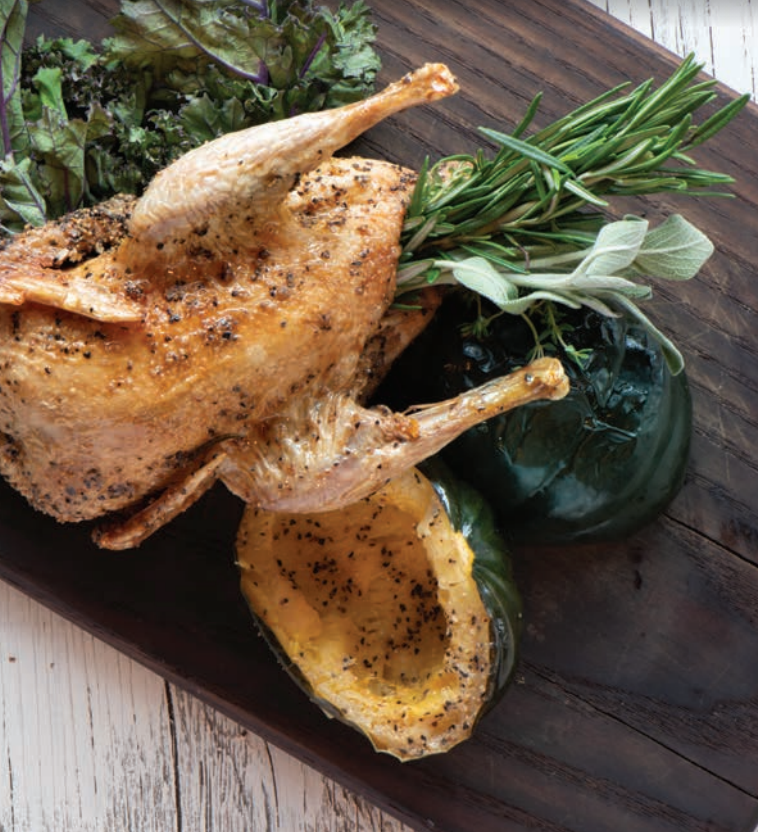From Tawaw
The perfect dish for a fall feast!
MAKES 2 SERVINGS | SPECIAL EQUIPMENT: LARGE STOCKPOT OR 8-QUART / 7 . 5 – L F O O D – S A F E
CONTAINER; ROASTING PAN
Pheasants are not native to North America—they were introduced from Asia in the early 1800s — but they’re now so common that they are part of the game bird category for hunting. They range in weight from 2 to 4 lbs/ 900 g to 1.8 kg and are really tasty when roasted. Pheasants are normally hunted in the fall because they’re fattening up for winter, which is also when winter squash, like acorn squash, is in season. Unsurprisingly, the two make a great pairing. Once you’ve served this dish, reserve the pheasant carcass and extra bits to make Pheasant Broth, a delicious alternative to chicken broth.
FOR THE BRINE
8 cups/2 L water
1⁄2 cup /125 mL coarse kosher salt
1⁄4 cup /60 mL good-quality organic honey
8 cloves garlic, peeled and crushed, divided
2 tbsp /30 mL whole black peppercorns
1 lemon, halved
FOR THE PHEASANT
1 pheasant, plucked and cleaned
Several sprigs of fresh sage, rosemary, and thyme
Salt and freshly ground black pepper, to taste
FOR THE ACORN SQUASH
1 medium acorn squash
1 tbsp /15 mL canola oil
Salt and freshly ground black pepper, to taste
1⁄4 tsp /1 mL rubbed sage
3 large kale leaves, for garnish (optional)
Pea shoots, for garnish (optional)
1 In a large stockpot or an 8-quart/ 7.5-L food-safe container, bring the water, salt, honey, 4 cloves of the garlic, peppercorns, and lemon halves to a boil. Stir and cover. Remove from the heat and set aside to cool completely.
2 Once the brine is cool, put the pheasant into the brine. Cover and refrigerate for at least 4 hours, or overnight.
3 Preheat the oven to 400°F/200°C (see Tip). Line a baking sheet in parchment paper.
4 Drive the tip of a long, sharp knife into the squash and carefully push down to cut it lengthwise in half. Using a spoon, scoop out the seeds and discard. Brush the inside of the squash with oil and season with salt, pepper, and rubbed sage. Place cut-side up on the prepared baking sheet. Set aside.
5 Remove the pheasant from the brine and pat dry with paper towel (discard brine). Stuff the cavity with the fresh herbs and the remaining 4 garlic cloves. Rub generous amounts of salt and pepper all over the skin. Place the pheasant in a roasting pan and put on the lowest rack in the preheated oven. Put the squash on the rack above. Reduce the heat to 350°F/ 180°C and roast both for 30 to 40 minutes: The squash flesh should be golden brown and soft; the internal temperature of the pheasant should reach 165°F/ 72°C. Remove the pans from the oven and let the pheasant rest for about 10 minutes.
6 Carve the pheasant and arrange on a platter with the roasted squash halves, or leave the pheasant whole and carve at the table. If you like, place the pheasant on a few leaves of kale to help the bird sit more firmly on the platter. Garnish the squash with fresh pea shoots, if you wish.
Excerpted from tawâw Progressive Indigenous Cuisine by Shane M. Chartrand with Jennifer Cockrall-King. Copyright © 2019 Shane Mederic Chartrand and Jennifer Cockrall-King. Reproduced with permission from House of Anansi Press Inc., Toronto. All rights reserved. www.houseofanansi.com

Nada’s Tips & Tricks: Couldn’t find pheasant so used a chicken. The brine and herbs come through nicely in the roast. I used chicken stock instead of the pheasant stock. And I LOVE squash so this was a nice side for the chicken and potatoes. Skipped the kale as no one in the house likes it. A really nice autumn meal!


